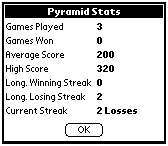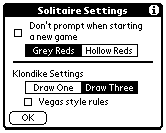| 3 |
The Games |
3.1 |
Bristol |
| |
The goal of Bristol is to stack all the cards on the foundations
from Ace to King, regardless of suit. |
| |

|
3.1.1 |
Rules |
| |
The main thing to remember when playing Bristol is that
the suit of the cards doesn't matter in the slightest. You start the game
with eightcolumns with three cards in each one. You can stack cards on the
columns in descending order, again regardless of suit. Only the top card
of each column can be moved.
Bristol keeps the remaining cards in a deck. If you tap
on the deck, it deals one each card to the top of three discard piles. The
top card of each discard pile can be placed on either a column or a foundation.
You can only go through the deck once, but any cards on the discard piles
that are revealed through play can be used as well. |
3.1.2 |
Scoring |
| |
Every card that you place on a foundation is worth 20 points.
Any card that you move from the discard pile to a column is worth 10 points. |
3.2 |
Eight Off |
| |
The object of Eight Off is to build up the four foundation
piles from Ace to King in suit. |
| |

|
3.2.1 |
Rules |
| |
You begin a game of Eight Off with eight columns of six
cards each. There are four empty foundations, and a row of eight spaces
at the bottom. When building on to columns, you may stack cards in descending
order by suit. The eight spaces at the bottom of the screen can hold one
card each. You can only move one card at a time; either the top card of
a column, or a card from one of the eight spaces at the bottom of the screen.
Cards may be moved to a foundation, a column, or one of the eight holding
spaces. If a column has no cards, you may play any card onto the column.
If it looks like you grabbed a stack of cards and moved
them all at once,
Solitaire Games is really moving each card for you individually
to one of the
empty places at the bottom of the screen, and then to the
destination. |
3.2.2 |
Scoring |
| |
For every card placed on a foundation, you receive 20 points. |
3.3 |
Klondike |
| |
The goal of Klondike is to build up the four foundation piles
from Ace to King, by suit. |
| |

|
3.2.1 |
Rules |
| |
Solitaire Games has three different variations of Klondike.
Standard Rules Build columns in descending order in alternating
colors. Blocks of cards in descending order and alternating colors are moved
as a group. If a column is empty, you may start a new column with a King.
Foundations are started with Aces, and built in suit to Kings. Klondike
also has a deck of cards. Tap on the deck to deal three cards at a time
to single discard pile. You may play the top card of the discard pile as
normal. Once the entire deck has been dealt, the discard pile it turned
over and becomes the deck. You can go through the deck unlimited times.
Alternate Rules The alternate rules make the game easier
by dealing one card at a time instead of three. Tap the silkscreen Menu
button and choose Settings to set Klondike to deal one or three cards at
once.
Vegas Rules The Vegas Rules are the strictest rules for
Klondike. Three cards at a time, but you can only deal through the deck
three times. The scoring is different as well, as described in the scoring
section. |
3.3.2 |
Scoring |
| |
Standard and Alternate Rules Scoring You receive 25 points
for every card that you place on a foundation, and 15 points for every card
that is moved from the discard pile to a column.
Vegas Rules You begin the game with -$52. Every card that
you place on a foundation gives you $4. |
3.4 |
Poker Square |
| |
The goal of Poker Square is to score as many points as possible.
You score points by making poker hands both vertically and horizontally. |
| |
 |
3.4.1 |
Rules |
| |
In Poker Square, the cards are dealt in a five card by five
card square. Tap a card to select it, and then on a second card to exchange
the two card's positions in the square. Dragging the first card on top of
the second one also exchanges their position. Any card can be exchanged
with any other card in the square. |
3.4.2 |
Scoring |
| |
Your total score in Poker Square is found by adding the
scores for the five vertical columns with the scores of the five horizontal
rows. The amount of points you get for each column or row is determined
by the poker hand in each one. The points for each type of hand are listed
below.
Royal Flush (10,J,Q,K,A in the same suit): 100 Straight
Flush (Five consecutive cards in the same suit): 75 Four of a Kind: 50 Full
House (Three of a Kind and a Pair): 25 Flush (Five cards of the same suit):
20 Straight (Five consecutive cards regardless of suit): 15 Three of a Kind:
10 Two Pair: 5 One Pair: 2
Any score over 200 means you have done well. |
3.5 |
Pyramid |
| |
The goal of Pyramid is to remove all of the cards from the
pyramid. |
| |

|
3.5.1 |
Rules |
| |
To remove cards from the pyramid, you need to select two cards
who's total value is 13. Numbered cards are worth their face value, Jacks
are 11, Queens are 12, Kings are 13, and Aces are 1. To remove cards, tap
one card to select it. Then, tap a second card. If the combined value of
the cards is 13, then both cards are removed. Kings, worth 13 points, are
the only card that can be removed by themselves. Only the cards that are
completely uncovered can be removed. You can also use the top card of the
discard pile to help you remove cards from the pyramid. Tap the deck to
deal cards out one by one. If the top two cards in the discard pile total
13, then you can remove them both by double tapping the top card. |
3.5.2 |
Scoring |
| |
In Pyramid, you receive 25 points for every time you remove
a card or cards whose value adds up to 13. |
3.6 |
Black Hole |
| |
The goal of Black Hole is to stack all of the cards on the
foundation in the lower right hand corner. |
| |

|
3.6.1 |
Rules |
| |
Black Hole's foundation begins with an Ace. You can build
onto the foundation with the top card from any of the 17 columns. The Ace
counts as both a high card and a low card, so you can build off of it with
both Kings and 2's. You cannot move cards between the columns and empty
columns cannot be filled, so plan your actions carefully. |
3.6.2 |
Scoring |
| |
Every card that you move onto the foundation is worth 25 points. |
3.7 |
Calculation |
| |
In Calculation, you want to stack all of the cards on the
four foundations. |
| |

|
3.7.1 |
Rules |
| |
Calculation starts you off with four foundations, four
empty columns, and a deck with 48 cards. The first foundation starts with
an Ace, the second with a 2, the third with a 3, and the fourth with a 4.
The first foundation is built in the following order, regardless
of suit: A, 2, 3, 4, 5, 6, 7, 8, 9, 10, J, Q, K
The second foundation is built in the following order regardless
of suit: 2, 4, 6, 8, 10, Q, A, 3, 5, 7, 9, J, K
The third foundation is built in the following order regardless
of suit: 3, 6, 9, Q, 2, 5, 8, J, A, 4, 7, 10, K
The fourth foundation is built in the following order regardless
of suit: 4, 8, Q, 3, 7, J, 2, 6, 10, A, 5, 9, K
Suit doesn't matter at all in Calculation. Any cards that
cannot be immediately played can be placed on any of the four columns. Only
the top card on any of the columns, or the top card of the deck can be played
on to any of the foundations. You win the game if all four foundations are
built up to the King. |
3.7.2 |
Scoring |
| |
Any card moved to one of the columns is worth 10 points, and
any card moved to a foundation is worth 25. |
3.8 |
Carpet |
| |
The goal of Carpet is to stack all the cards on to the four
foundations in order from Ace to King, and in suit. |
| |
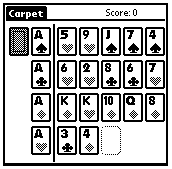
|
3.8.1 |
Rules |
| |
Carpet starts you out with four foundations, with one Ace
placed in each one. There are also eighteen spaces that can hold one card
each. At the start of a game, seventeen of the spaces have cards in them.
To play, tap on the deck to deal a card. The dealt card
goes face up on the discard pile. The goal of Carpet is to build all four
of the foundations from Ace to King, in suit. To do so, you can move any
card from the eighteen holding spaces, or the top card of the discard pile.
Cards from the discard pile can be played on a foundation, left in the discard
pile, or moved to and empty holding space. |
3.8.2 |
Scoring |
| |
Any card moved on to a foundation gives you 25 points. Any
card moved from the discard pile to one of the holding spaces gives you
15 points. |
3.9 |
Golf |
| |
The object of Golf is to remove all of the cards from the
seven columns. |
| |
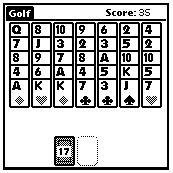
|
3.9.1 |
Rules |
| |
To start a game of Golf, choose the top card from any of the
seven columns, and place it on the foundation. You can then build off of
the foundation card in either direction, regardless of suit. When you are
out of moves, tap the deck to deal a new card on the foundation. Then, you
can play what ever cards you can on the new foundation card. You can only
play the top card from a column, and nothing can be played on a King. |
3.9.2 |
Scoring |
| |
When you start the game, you have 35 points. Every card that
you place on the foundation from any of the columns lowers the score by
one. To win the game you remove all of the cards from the columns, which
leaves you with a score of zero. |
3.10 |
Spiderette |
| |
The goal of Spiderette is to build each suit from Ace to King
and place them on the foundations. |
| |
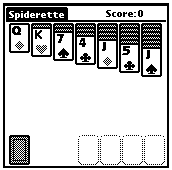
|
3.10.1 |
Rules |
| |
Although the ultimate goal of Spiderette is to have each
suit built from Ace to King on the foundations, it adds more difficulty
to the game by making you build a complete suit from Ace to King on the
columns before moving all 13 cards to the foundation.
You can stack cards numerically on the columns, regardless
of suit. However, only the top card of each column can be moved. The only
exception to this rule is if you have cards built not only numerically,
but in the same suit. Then, you can move all the cards in that group as
a whole. For example, if you have the 3, 4, 5, 6, and 7 of Hearts stacked
together in order, then they can all be moved as a unit.
If you get stuck, you can tap the deck to deal yourself
more cards. Each deal places one card on each of the columns.
When you have a suit built from Ace to King on a column,
you can move the entire block of cards to a foundation. Until a suit is
completely built, no cards can be moved to a foundation. |
3.10.2 |
Scoring |
| |
You receive 325 points for each complete group of cards stacked
from Ace to King of the same suit that is placed on a foundation. |



